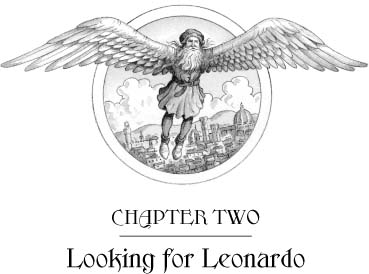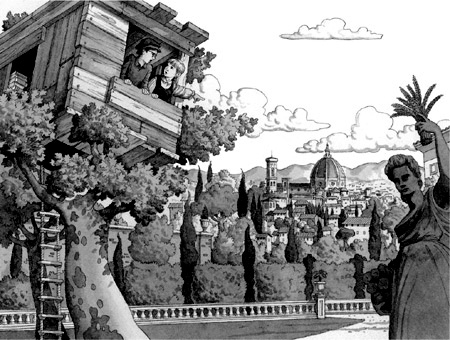

A different bell was bonging in the distance. Bright early sunlight poured through the tree house window. Teddy and Kathleen were gone.
Jack looked down at his clothes. He was wearing a knee-length tunic and dark tights. Annie wore a long dress with puffy sleeves. Jack’s backpack had changed into a cloth bag.
Jack and Annie looked out the window. The tree house had landed in a tall tree in a garden surrounded by green hedges. Beyond the garden was a sea of red-tiled roofs. A huge eight-sided dome and a stone tower rose high above the red rooftops.

“Welcome to Florence, Italy,” said Annie.
Jack opened their book and read aloud:
In the early 1500s, many artists and craftspeople lived in the city of Florence. The city was filled with silk weavers, potters, and marble workers. Artists made sculptures, paintings, and tapestries.
“Cool,” said Annie. “I love art.”
Jack read more:
But the most amazing genius of that time did a bit of everything. Leonardo da Vinci was not only a great painter but also an inventor, architect, stage and costume designer, horseman, chef, geologist, and botanist.
“What’s a geologist and a botanist?” said Annie.
“They’re scientists,” said Jack. “A geologist studies rocks, and a botanist studies plants.” He turned the page.
“Come on, we should go,” said Annie. “The tree house probably brought us right to Leonardo. We have to find him before he gets away!”
“Oh, right,” said Jack.
Annie started down the ladder. Jack packed up their research book and climbed down after her.
Jack and Annie walked around the tall hedge and came to a busy road that ran along a river. They stared at all the people going by. There were women in long silk dresses, priests in black robes riding donkeys, and soldiers in blue capes riding horses.
“I don’t see anyone who looks like the guy on the cover of our book,” said Jack.
“Let’s ask someone,” said Annie. She walked over to a girl selling flowers by the road. “Excuse me. Do you know a person named Leonardo da Vinci?”
“Of course! Everyone knows Leonardo!” said the girl. “He was just here! He bought some flowers from me. He said he was going to sketch them later.” Her eyes shone with excitement.
“Where did he go?” asked Jack.
“He headed toward the Old Bridge,” the girl said. She pointed toward a covered bridge farther down the road.
“Thanks!” said Annie.
Jack and Annie walked quickly along the bank of the river toward the bridge. “You were right,” said Jack. “The tree house brought us right to Leonardo. But while we were talking, he kept walking.”
“Don’t worry,” said Annie. “We’ll catch up to him.”
The covered bridge was supported by three stone arches. It looked like a long house stretching over the river.
As they crossed the bridge, it was hard to look for Leonardo. The light was dim and the walkway inside the bridge was filled with people.
Jack and Annie squeezed through the crowd to the other side of the bridge. The sunlight was so bright that Jack still couldn’t see clearly. He shaded his eyes with his hand. “I still don’t see him,” he said.
“We can ask again,” said Annie. “That girl said everyone knows Leonardo!” She headed to a shop near the riverbank. Weavers were hanging colorful fabrics on a line. The red and purple silks waved in the breeze.
“Excuse me!” Annie called. “Have you seen Leonardo da Vinci this morning?”
A toothless old woman smiled. “Oh, yes! Leonardo passed by only a moment ago,” she said. “On his way to the bakery, I think.” She pointed down a narrow lane. “He goes there every morning.”
“Thanks!” said Annie.
Jack and Annie hurried to the bakery. The delicious smell of baking bread filled the air.
“Excuse me, did Leonardo da Vinci come in here?” Jack asked.
“Yes, he just bought his daily loaf of bread,” said the baker. “He always goes to the cheese shop next.” He pointed across the street.
“Thanks!” said Jack.
Jack and Annie crossed the busy street to the cheese shop. “Is Leonardo da Vinci here?” asked Annie.
“He just left,” said the cheese man. He pointed up the street. “He was going to the blacksmith’s.”
“Oh, brother,” said Jack.
“Thanks!” said Annie, and they headed up the street.
“I can’t wait to meet him!” said Annie.
“Me too,” said Jack. “If we ever catch up to him.”
Loud hammering noises were coming from a shop. Jack and Annie looked inside and saw a blacksmith pounding a horseshoe with a huge iron hammer. A fire was roaring in a hearth nearby.
“Excuse me!” Jack shouted.
The burly man stopped pounding.
“Was Leonardo da Vinci just here?” asked Jack.
“Yes, he paid me for his iron pots,” the blacksmith said gruffly. “Finally.”
“Do you know where he was going next?” asked Jack.
“Headed for the market, in a big hurry, as usual,” said the blacksmith, nodding toward the street. Then he went back to pounding.
Jack and Annie ran up the street. They rounded a corner and stepped into a huge square. Sunlight shone down on hundreds of tents and stalls. The air smelled of fish and cinnamon and other spices.
“Oh, man,” said Jack. “It’s huge!”
The market was jam-packed with shoppers. It was hard to see over the heads of all the grownups. “We could spend all day looking for Leonardo here,” said Jack.
“This is not good,” said Annie. “We’re supposed to spend the day helping him, not looking for him! Remember the rhyme said, ‘Help the genius all day long, morning, noon, and afternoon, till the night bird sings its song.’”
“Yeah, whatever that means,” said Jack.
“Hey, maybe we should use the wand now,” said Annie. “This situation fits the rules. Finding Leonardo is not just for our good—it’s to help Merlin. And I think we’ve tried our hardest.”
“Okay, let’s use it.” Jack slipped the Wand of Dianthus out of his bag and handed it to Annie. “Five words,” he said.
“I know, I know,” she said. She held up the wand and counted her words on her fingers: “Help. Us. Find. Leonardo. Now.”
Jack and Annie held their breath and waited. But nothing changed. Everything around them looked exactly the same.
“It’s not working,” said Jack. “What did we do wrong?”
“I don’t know,” said Annie. “I used five words.
It’s definitely good for others. Maybe we haven’t really tried our hardest yet.”
Jack sighed. “Okay let’s keep trying.” He took back the wand and slipped it into his bag.
“Oh, look at the birds over there!” said Annie. She pulled Jack over to a stall that sold caged birds. Only one bird was singing: a brown bird with a reddish tail. He was very plain, but he sang beautifully with whistles and trills.
“Hi, you,” said Annie.
The bird tilted his head and looked straight at Annie. He chirped softly.
“Come on, Annie, we can’t waste time here,” said Jack. “We have to keep looking for Leonardo.”
“But didn’t you hear his song?” said Annie. “He wants to fly away. He wants to be free.”
Jack looked around for the bird seller. He was standing nearby talking to a customer. “Forget it, Annie. We don’t have money to pay for him,” said Jack.
“But he wants me to help him,” said Annie. “I can feel it.” She reached toward the cage door.
“Annie, don’t!” said Jack.
But Annie unlatched the door. The bird hopped onto the ground.
“Oh, no!” said Jack. He grabbed for the bird, but he was too late. The brown bird was already flying away into the blue sky.
“Yay!” said Annie.
“Hey!” shouted the bird seller, rushing over to them. “Were you trying to steal my bird?”
“We weren’t stealing him!” said Annie. “We were setting him free!”
The bird seller grabbed Jack by the arm. “You’ll have to pay for him, then!” he barked.
“But … but …,” stammered Jack.
“Marco, unhand that boy!” a man’s voice boomed.
Jack turned to see a tall man in a purple cloak and floppy blue cap. He had a long nose, bright, kind eyes with heavy eyebrows, and a flowing beard. He looked exactly like the man on the cover of their book.
“Leonardo!” said Annie. “The wand worked!”